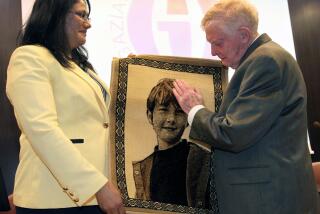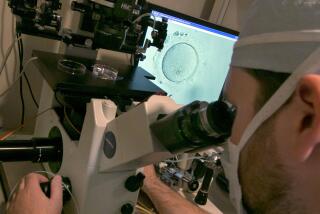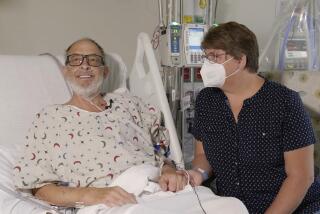Baby Missing Most of Brain Kept Alive as Organ Donor
A day-old baby boy born with most of his brain missing was being kept alive on a respirator late Wednesday at Loma Linda Medical Center as doctors waited to see whether his heart and perhaps other organs might be transplanted into other infants.
If the baby is declared brain dead within seven days, and one or more of his organs successfully transplanted, it will be the first time that the controversial procedure has been tried using a so-called anencephalic baby born in the United States.
“I think there is a tremendous amount of historical importance in this,” said Dr. Leonard L. Fox, the Anaheim neonatologist who referred the baby’s family to Loma Linda. “More importantly, it’s an opportunity to provide life where there may not have been that opportunity.”
Anencephalic babies are born with neither the tops of their skulls nor the higher brain centers that control thought and feelings. With only a small brain stem to power their lungs and heart, such infants usually die within hours or days of birth.
The baby, who has remained anonymous at his parents’ request, was born Tuesday evening at Martin Luther Hospital in Anaheim. The mother, a woman in her mid-20s, had arrived at the hospital in labor. The baby’s condition was detected by ultrasound that afternoon.
According to Fox, the parents asked that the baby’s organs be donated. Fox then contacted Loma Linda, believed to be the only hospital in the country that has set up procedures for harvesting organs from anencephalic infants.
The baby, weighing between 7 and 8 pounds, was transferred to Loma Linda, where hospital officials said there already were signs of brain stem death.
Breathing Support
“We give the baby oxygen and mechanical breathing support,” Dick Schaefer, a hospital spokesman, said in a telephone interview. “All that does is it puts oxygen in the blood and keeps the organs healthy while the baby dies.”
The use of anencephalic infants as organ donors, however, has raised questions among medical ethicists and others.
Some have questioned the morality of prolonging a life solely to harvest organs, rather than to benefit the patient. Others say the use of respirators may make it more difficult to determine when a baby dies, raising the risk of removing organs from a living patient.
Furthermore, physicians do not know whether anencephalic babies are capable of feeling pain. Although hospital officials have said they will administer a painkiller if there are signs of distress, some doctors say the painkiller could make brain death more difficult to determine.
Some 3,500 anencephalic babies are born in this country each year. About half are born dead. Ordinarily, the others are given warmth, hydration and nourishment and die within a week. Because they die slowly, their organs deteriorate and are unsuitable for transplant.
Baby Stillborn
In hopes of salvaging those babies’ hearts for some of the estimated 500 to 650 babies born each year needing heart transplants, Loma Linda officials late last year drew up extensive guidelines under which brain-dead anencephalic babies would be used as organ donors.
Those procedures were to have been used for the first time in December in the case of Brenda and Michael Winner, an Arcadia couple who had offered to donate the organs of their anencephalic baby. However, the baby was stillborn.
Under Loma Linda’s guidelines, the baby born Tuesday will remain on the respirator until he is declared brain dead by two physicians independent of the case. If brain death does not occur within seven days of birth, he will be removed from the respirator and allowed to die.
If and when there is a declaration of brain death, he will be entered as a donor into the computerized national organ procurement network. The computer will attempt to match the baby’s organs, including the heart or liver, with one or more potential recipients registered in the system.
No Recipient Lined Up
Loma Linda currently has no potential recipient with the same blood type in need of a heart, Schaefer said. If a match is found, the Orange County baby may be transferred to the hospital where the transplant will be done for removal of the organs, Schaefer said.
If no recipient is found before or soon after the donor baby’s death, the organs will go to waste, as a heart can be kept alive only four hours outside the body.
The first North American case in which an anencephalic baby was used as an organ donor occurred at Loma Linda last October when a team led by Dr. Leonard Bailey transplanted the heart of a Canadian-born anencephalic girl into the chest of 2-day-old Paul Holc. That baby had been declared brain dead in Canada before being transferred to Loma Linda.
Paul, who lives with his parents in a suburb of Vancouver, became the world’s youngest heart transplant recipient.
More to Read
Sign up for Essential California
The most important California stories and recommendations in your inbox every morning.
You may occasionally receive promotional content from the Los Angeles Times.










